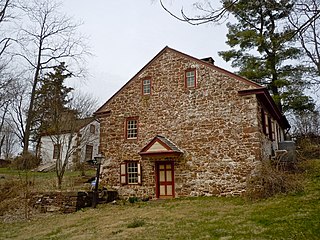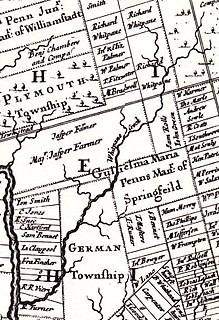
The Chesapeake & Delaware Canal is a 14-mile (22.5 km)-long, 450-foot (137.2 m)-wide and 35-foot (10.7 m)-deep ship canal that connects the Delaware River with the Chesapeake Bay in the states of Delaware and Maryland in the United States.

Woodmont is a mansion and hilltop estate of 72 acres (29 ha) in Gladwyne, a suburb of Philadelphia, Pennsylvania, United States. In 1953, it became the home of evangelist Father Divine, and the center of his International Peace Mission movement. It was declared a National Historic Landmark in 1998 for its well-preserved Chateau-style architecture, and for its association with Father Divine.

Wheatland, or the James Buchanan House, is a brick, Federal style house outside of Lancaster, Pennsylvania, in Lancaster Township, Lancaster County. It was formerly owned by the 15th president of the United States, James Buchanan.

William Montgomery was a colonial-American patriot, pioneer, soldier, public servant, and abolitionist.

The Woodlands is a National Historic Landmark District on the west bank of the Schuylkill River in Philadelphia. It includes a Federal-style mansion, a matching carriage house and stable, and a garden landscape that in 1840 was transformed into a Victorian rural cemetery with an arboretum of over 1,000 trees. More than 30,000 people are buried at the cemetery.

Bartram's Garden is a 50-acre public garden and National Historic Landmark in Southwest Philadelphia, Pennsylvania, situated on Lenape territory on the banks of the Tidal Schuylkill River. It is a venue for art, an access to the tidal river and wetlands, an outdoor classroom, and a living laboratory. Founded in 1728 by botanist John Bartram (1699–1777), it is the oldest surviving botanical garden in North America. Bartram's Garden attempts to hold the colonial legacy of the land with a commitment to learn and share the whole truth about of the plants of Southwest Philadelphia and the people who grow them.

Norristown Farm Park is a 690-acre (279 ha) Pennsylvania state park in East Norriton and West Norriton Townships and the Borough of Norristown, Montgomery County, Pennsylvania, in the United States. It is operated in partnership with the Montgomery County Department of Parks. The park is a working farm on the site of Norristown State Hospital. Many colonial era farm buildings and homes are on the grounds. Hiking, bicycling, ball fields, fishing, picnicking, and cross-country skiing are available in the park. The park hosts musical concerts in the summer. Stony Creek flows through the park. Norristown Farm Park is just off Interstate 276 on West Germantown Pike.
Brandywine Battlefield Historic Site is a National Historical Landmark. The historic park is owned and operated by the Pennsylvania Historical and Museum Commission, on 52 acres (210,000 m2), near Chadds Ford, Delaware County, Pennsylvania in the United States. It is part of the site of the Battle of Brandywine fought on September 11, 1777, during the American Revolution. The Battle of Brandywine covered more than ten square miles, or 35,000 acres. However, the modern park only covers 50 acres which served primarily as the Continental encampment the two days prior to the battle. The battle was a decisive victory for the British and cleared a path directly to the rebel capital of Philadelphia. Brandywine Battlefield Park became a Pennsylvania State Park in 1949 and a National Historic Landmark in 1961.

Fricks Locks Historic District or more simply Frick's Lock is an abandoned village, along the also abandoned Schuylkill Canal, in the northeast portion of East Coventry Township, Chester County, Pennsylvania. This 18th-century village outlasted the canal, being abandoned in the late 20th century with the construction of the adjacent Limerick Nuclear Power Plant. The village on about 18 acres of land were listed as a historic district by the National Register of Historic Places in 2003. Frick's Locks is considered a modern ghost town and, although private property, attracts visitors.
The Colonsay Plantation was one of the very earliest tracts of land to be granted in the Ceded Lands, while the Province of Georgia still belonged to the British Crown. It was named after the Scottish island Colonsay.
The Rio Grande Ranch Headquarters Historic District is a historic one-story residence located 3 miles (4.8 km) east of Okay in Wagoner County, Oklahoma. The site was listed on the National Register of Historic Places September 9, 1992. The site's Period of Significance is 1910 to 1935, and it qualified for listing under NRHP criteria A and C.

Rose Hill Manor, now known as Rose Hill Manor Park & Children's Museum, is a historic home located at Frederick, Frederick County, Maryland. It is a 2+1⁄2-story brick house. A notable feature is the large two-story pedimented portico supported by fluted Doric columns on the first floor and Ionic columns on the balustraded second floor. It was the retirement home of Thomas Johnson (1732–1819), the first elected governor of the State of Maryland and Associate Justice of the United States Supreme Court. It was built in the mid-1790s by his daughter and son-in-law.

The Charles Boyd Homestead is a group of three buildings that make up a pioneer ranch complex. It is located in Deschutes County north of Bend, Oregon, United States. The ranch buildings were constructed by Charles Boyd between 1905 and 1909. Today, the three surviving structures are the only ranch buildings that date back to the earliest period of settlement in the Bend area. The Boyd Homestead is listed as a historic district on the National Register of Historic Places.

The Newlin Mill Complex, also referred to as The Newlin Grist Mill, is a water-powered gristmill on the west branch of Chester Creek near Concordville, Pennsylvania was built in 1704 by Nathaniel and Mary Newlin and operated commercially until 1941. During its three centuries of operation, the mill has been known as the Lower Mill, the Markham Mill, the Seventeen-O-Four Mill and the Concord Flour Mill. In 1958 the mill property was bought by E. Mortimer Newlin, restored and given to the Nicholas Newlin Foundation to use as a historical park. Water power is still used to grind corn meal which is sold on site. The park includes five historical buildings, which were added to the National Register of Historic Places in 1983, and 150 acres (61 ha) of natural woodland.

The Zook House, also known as the William and Elizabeth Owen House, built in 1750, is a historic single-family dwelling located near Exton, Pennsylvania on the property of the Exton Square Mall, on the north side of U.S. Route 30 Business. It was first listed on the National Register of Historic Places on January 1, 1976, following renovations. In 1984 a boundary increase was also listed on the National Register. In 1998 the house was moved about 300 feet to the southwest due to an expansion of the shopping mall. On July 27, 2000, the house was re-listed on the National Register, even though it remains listed on the Register at its old address.

The Mordecai Lincoln House is a historic house in Exeter Township, Berks County, Pennsylvania built c. 1733 by Mordecai Lincoln, the great-great-grandfather of President Abraham Lincoln. The house stands in the narrow valley of Hiester Creek on a 9-acre plot near the village of Lorane on Lincoln Road.

Spring Mill is a small unincorporated community in Whitemarsh Township, Montgomery County, Pennsylvania.

The Pettengill House and Farm is a historic conservation property in Freeport, Maine, United States. Now owned by the Freeport Historical Society, this farm was in active use from at least 1831 until 1960. More than 140 acres (57 ha) of its original 180 acres (73 ha) have been preserved, as has the c. 1800 saltbox farmhouse. The property was listed on the National Register of Historic Places in 1970, and is part of the 1974 Harraseeket Historic District. The farm is located at the southern end of Pettengill Road in Freeport's Mast Landing area. The house faces south, looking down the Harraseeket River. The property's trails are open to the public daily from dawn to dusk.

Fatland – also known as "Fatland Farm," "Fatland Ford" and, currently, "Vaux Hill" – is a Greek Revival mansion and estate in Audubon, Pennsylvania. Located on the north side of the Schuylkill River, opposite Valley Forge, the property was part of the Continental Army's 1777-78 winter encampment. On consecutive days in September 1777, its stone farmhouse served as headquarters for General George Washington and British General Sir William Howe.

Pencoyd was a historic house and farm in Bala Cynwyd, Lower Merion Township, Montgomery County, Pennsylvania. Located along the north side of what is now City Avenue, the farm originally stretched from the Schuylkill River to Conshohocken State Road. Settled by John Roberts in 1683, his descendants owned the property for 280 years. The house was built c.1684–1690, and demolished in 1964.























